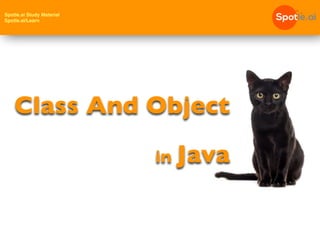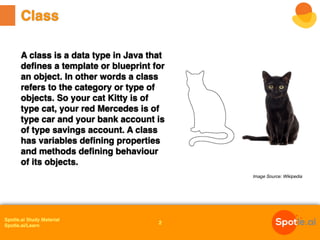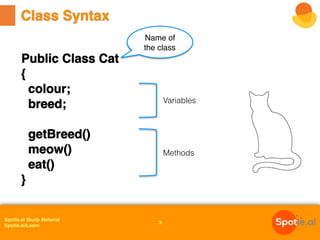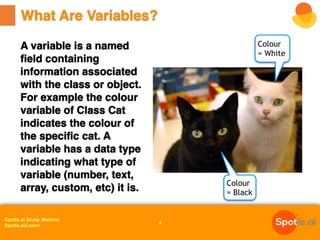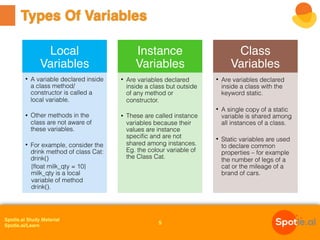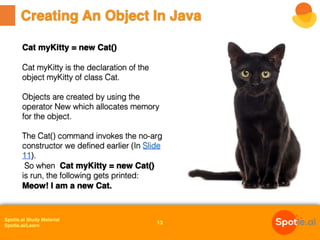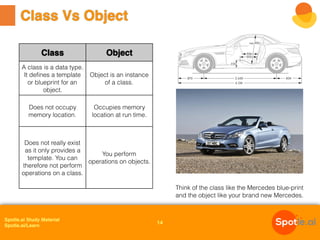Class and Objects in Java
- 1. Spotle.ai Study Material Spotle.ai/Learn Class And Object in Java
- 2. Spotle.ai Study Material Spotle.ai/Learn A class is a data type in Java that defines a template or blueprint for an object. In other words a class refers to the category or type of objects. So your cat Kitty is of type cat, your red Mercedes is of type car and your bank account is of type savings account. A class has variables defining properties and methods defining behaviour of its objects. Class Image Source: Wikipedia 2
- 3. Spotle.ai Study Material Spotle.ai/Learn Class Syntax 3 Public Class Cat { colour; breed; getBreed() meow() eat() } Variables Methods Name of the class
- 4. Spotle.ai Study Material Spotle.ai/Learn A variable is a named field containing information associated with the class or object. For example the colour variable of Class Cat indicates the colour of the specific cat. A variable has a data type indicating what type of variable (number, text, array, custom, etc) it is. What Are Variables? 4 Colour = Black Colour = White
- 5. Spotle.ai Study Material Spotle.ai/Learn Types Of Variables 5 Local Variables • A variable declared inside a class method/ constructor is called a local variable. • Other methods in the class are not aware of these variables. • For example, consider the drink method of class Cat: drink() {float milk_qty = 10} milk_qty is a local variable of method drink(). Instance Variables • Are variables declared inside a class but outside of any method or constructor. • These are called instance variables because their values are instance specific and are not shared among instances. Eg. the colour variable of the Class Cat. Class Variables • Are variables declared inside a class with the keyword static. • A single copy of a static variable is shared among all instances of a class. • Static variables are used to declare common properties – for example the number of legs of a cat or the mileage of a brand of cars.
- 6. Spotle.ai Study Material Spotle.ai/Learn What Is A Class? 6 What is your colour? But you cannothide your no_of_legs. Thatis a static variablein Class Cat! Instance And Static Variables My colour is my colour. None of your colour!
- 7. Spotle.ai Study Material Spotle.ai/Learn Methods are used to describe behaviour of the objects of a class. A method is a set of statements which is referred to by name and can be invoked at any point in a program. It performs a logical unit of work. For example get_mileage() method in class Car is used to return a specific car’s mileage. In our cat example, meow() and drink_milk are methods of the cat objects. What Are Methods? 7 Meow() Meow()
- 8. Spotle.ai Study Material Spotle.ai/Learn Public int getMileage() { return mileage; } Public void refuel(float fuel) { total_fuel = total_fuel + fuel; } Syntax Of A Method 8 Return type indicates the data type of the variable returned by a method. This indicates the parameter with which the method is invoked from within a program. This is the method name. The body of the method describes the functionality.
- 9. Spotle.ai Study Material Spotle.ai/Learn What Are Constructors? 9 Constructor is a block of code defined in a class that initializes the newly created object. A constructor is structurally very similar to an instance method in Java but it is not a method as it doesn’t have a return type. A constructor is automatically called when the instance of a class is created. Public class Cat { Cat() { System.out.println(“Meow !I am a new Cat.”) } } Definition Example
- 10. Spotle.ai Study Material Spotle.ai/Learn Types Of Constructors 10 If a class does not have any constructor, Java compiler inserts a default constructor into the code. A default constructor, for class Cat, looks like this. Note the body is empty: Cat() { } The default constructor is not inserted if you implement a constructor for your class. A no-argument constructor is one that takes no arguments or parameters. For example: Cat() { System.out.println(“Meow !I am a new Cat.”) } } Default Constructors Parameterized Constructors No Argument Constructors A constructor with arguments or parameters is known as a Parameterized constructor. For example: Cat( String msg) { System.out.println(“Meow !I am a new Cat with a special message” + msg) } }
- 11. Spotle.ai Study Material Spotle.ai/Learn Class Syntax - Revisited 11 public class Cat { string colour; string breed; static no_of_legs = 4 Cat() { System.out.println(“Meow !I I am a new Cat.”) } public void meow() { System.out.println(“Meow on demand!”); } } Variables Methods Name of the class Constructors
- 12. Spotle.ai Study Material Spotle.ai/Learn What Is An Object? Think of the class like the Mercedes blue-print and the object like your brand new Mercedes. 12 Object is an instance of a class. An object is a self-contained component with methods or behaviour and properties or state. Objects are the real world manifestation of a class like your house is the manifestation of the architect’s blue-print. Or your car is a real object of type car. Objects occupy memory location at run-time.
- 13. Spotle.ai Study Material Spotle.ai/Learn Creating An Object In Java 13 Cat myKitty = new Cat() Cat myKitty is the declaration of the object myKitty of class Cat. Objects are created by using the operator New which allocates memory for the object. The Cat() command invokes the no-arg constructor we defined earlier (In Slide 11). So when Cat myKitty = new Cat() is run, the following gets printed: Meow! I am a new Cat.
- 14. Spotle.ai Study Material Spotle.ai/Learn Class Object A class is a data type. It defines a template or blueprint for an object. Object is an instance of a class. Does not occupy memory location. Occupies memory location at run time. Does not really exist as it only provides a template. You can therefore not perform operations on a class. You perform operations on objects. Class Vs Object 14 Think of the class like the Mercedes blue-print and the object like your brand new Mercedes.

